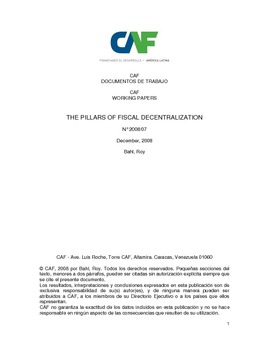RED 2025. Chapter 5: Subnational government revenues: The role of taxes and transfers
Resumen
This chapter examines the revenue structure of subnational governments in Latin America and the Caribbean, where, on average, 58% comes from transfers and 42% from own resources. The importance of funding with own resources for the quality of spending is highlighted, and the disparity in local revenues is addressed, proposing tax reforms to enhance collection. The role of transfers in reducing inequalities and the need to strengthen their redistributive component are discussed. Governance of natural resources to promote the extraction of critical minerals and hydrocarbons in the region is also analyzed.
En otros idiomas
Materia
País / Región
Fecha
2025Citar de esta publicación
Item perteneciente a la Colección
Autor
Camacho, CarolinaEstrada, Ricardo
Items Relacionados
Can a Mining Windfall Improve Welfare? Evidence from Peru with Municipal Level Data
In this paper we investigate whether fiscal performance is affected by the presence of natural resource revenues. We compare policy outcomes from ...
The pillars of fiscal decentralization
Fiscal decentralization can de be defined as the process of transferring budgetary authority from central government to elected subnational governments ...
The impact of taxes and social spending on inequality and poverty in Argentina, Bolivia, Brazil, Mexico and Peru: a synthesis of results
We apply a standard tax and benefit incidence analysis to estimate the impact on inequality and poverty of direct taxes, indirect taxes and subsidies, ...





